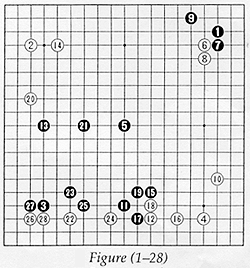Go Seigen, the 20th century's greatest player
In 1926, a professional go player, Kaoru Iwamoto, made a goodwill visit to China. There, he played two games with a 12-year-old Chinese boy named Wu Qing-yuan, giving the boy a handicap of three stones. The boy won both games, so the handicap was reduced to two stones and Iwamoto won by only two points. This was a stunning result as the strongest Chinese players at that time were about three stones weaker than the Japanese professionals. The following year another professional from Japan, Kohei Inoue, visited China and, playing black without a handicap, the boy won one game and lost another. According to Inoue: "This youth is already a great player and I was lucky to have won the game I did.These games made such an impression that a movement was started to bring the boy to Japan. When he arrived in 1928 he was awarded the rank of 3-dan and from then on he was known by the Japanese reading of his name, Go Seigen. By the time he was 18, Go was one of a small select group of the top players, among whom was his friend and rival Minoru Kitani.
In the 1933, Go and Kitani took a holiday together and spent the summer developing a new opening theory. When they returned to Tokyo and tried out their new strategy with phenomenal results. Go took first place in the autumn ranking tournament and Kitani second.
This new opening strategy, called "Shin Fuseki" in Japanese, took the go world by storm. It set off a craze of experimentation, producing original and even bizarre opening patterns among both professionals and amateurs.
What was this new opening strategy? In the past, the conventional strategy in the opening was to map out territory along the third line and to use two moves to enclose territory in the corner. In the new opening strategy, importance was shifted to building influence on the fourth line and developing rapidly by occupying the corners with just one move on the 4-4 or the 3-3 point. Black's moves in the Cho-Takemiya game in last week's column are an example of the modern version of this strategy.
In 1933, The Yomiuri Shimbun sponsored a go championship. The winner of this tournament was to play Honinbo Shusai, the last hereditary head of the Honinbo house. He is also known as Honinbo Shusai. Go, who was then only 19 (Shusai was 49), won the tournament and the Yomiuri promoted the upcoming game much as a heavyweight boxing match is promoted today, calling it "the clash of the century."
Since Go was Chinese, it was in a sense the first international go match, with the Chinese champion facing the Japanese. With growing anti-Chinese sentiment in some quarters at the time, the excitement over the match was raised to fever pitch, and there was a lot of pressure on Shusai to win. It was a hard-fought game in which Go was leading most of the way, but Shusai came up with a brilliant move and managed to win by two points.

Figure shows the first 28 moves of their game. Go Seigen's first three moves, Black 1, 3 and 5, were shocking at the time, and supporters of Shusai felt that they were insulting to this great player. No matter, the first 28 moves shown here are a good illustration of the difference between the new opening strategy and the old.
Black 1 was played on the 3-3 point. With this one move, Go secures the corner territory. Go then plays Black 3 on the 4-4 point in the opposite corner. This move is influence-oriented--White can take the corner territory, as he does with 26 later on, but Black will be able to obtain influence in the center.
Shusai encloses the territory in the lower right corner with White 10 and Black plays 11 to counter the influence these two stones radiate along the bottom.
Go then plays Black 13, mapping out a large box-shaped territorial framework in the lower left. Unperturbed, Shusai makes another tight territorial move, enclosing the corner with White 14. With Black 27, Black has strengthened his framework, while Shusai has secured the lower left corner with White 28.
In 1939, Go played a 10-game match with Kitani. He won the match 6-4, and it is considered one of the great matches of the century. Every game was a masterpiece. It was such a success that the sponsor, The Yomiuri Shimbun, arranged a series of 10-game matches with the top players of the day. Go convincingly defeated them all, proving he was at least one rank stronger than any of them.
Go retired as an active player in 1983, but two years ago he gave a series of highly popular lectures on NHK titled "Go in the 21st Century" in which he speculated on possible opening strategies that might be played during the next century.
